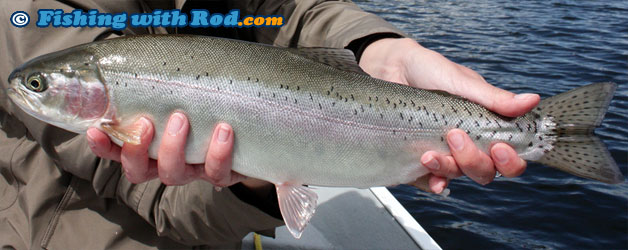Rainbow Trout
Oncorhynchus mykiss

In British Columbia, rainbow trout is the most popular target species among freshwater recreational fishermen. They can be caught throughout the year, in both streams and lakes, also sometimes in estuaries. Anglers enjoy catching them because they are aggressive feeders, strong fighters and excellent table fare.
Description
Rainbow trout can come in all sizes, colours, spotting patterns and shapes, depending on which "strain" or population they are from. Rainbow trout found in one stream in Southern British Columbia can look quite different to rainbow trout found in another stream in Northern or Interior British Columbia. The differences are due to a long period of adaptation to the environment where they are found in. Four particular strains of rainbow trout are cultured at hatcheries in British Columbia and stocked in many lakes for anglers to enjoy. They are Fraser Valley, Pennask, Blackwater and Gerrard rainbow trout.
General characteristics of rainbow trout are small spots across the dorsal portion of the fish. Most spots are above the lateral line, but some fish can have spots below the lateral line as well, mostly around the posterior region of the fish. Spots are also found across the entire tail, which is not forked or slightly forked. Pink colour is often present on the gill plates as well as along the lateral line. Adult rainbow trout can be between 1 and 10lb, but much larger fish are recorded in some populations such as the Gerrard rainbow trout found in the Kootenay region.
Steelhead, which are anadromous rainbow trout, are large adults weighing between 5 and 25lb when returning from the ocean.
Distribution
The natural distribution of rainbow trout is the Pacific drainage, from Alaska to California, bounded to the west of Rocky Mountains. This population range also extended to parts of Siberia. In the past century, rainbow trout have been widely introduced to almost all continents around the world due to recreational and commercial interests. They are raised in farms due to market demands and they are stocked in lakes to meet angling pressure. Established and self sustaining rainbow trout populations are now found in other parts of North America, Eastern Asia, Australia, New Zealand and South America.
Life History
Rainbow trout can be found in both rivers and lakes. They spawn in streams during spring months. Rainbow trout that inhabit in lakes travel up creeks when spawning, while river rainbow trout travel upstream to smaller channels when spawning.
Most stocked rainbow trout in lakes are sterile to prevent interbreeding with wild fish and promote their growth as energy is not used for spawning. Many lakes also lack creeks/spawning habitat so stocked rainbow trout can become egg bound (carrying unspawned eggs) if they are not sterile.
Rainbow trout primarily feed on insects in both streams and lakes. Chironomid, mayfly, dragonfly, damselfly, caddis and stonefly are just some common insects in their diet. In lakes, rainbow trout also feed on scuds, leeches. In coastal streams, rainbow trout also feed on salmon eggs and fry between fall and spring. Adult Gerrard rainbow trout in the Kootenay region feed on small fish such as kokanee, therefore they have the ability to reach much bigger size than other strains of rainbow trout.
Fishing Locations
In British Columbia, anglers have plenty of options when looking for a location to catch rainbow trout. The Freshwater Fisheries Society of BC is responsible for stocking rainbow trout into hundreds of lakes across the province. These lakes can either be urban or remote, accessed by either from shore or a boat.
In Region one (Vancouver Island) and Region two (Lower Mainland and Fraser Valley), there are dozens of urban lakes where rainbow trout fishing is good throughout the year. In Region three (Thompson-Nicola) and five (Cariboo), excellent rainbow trout fishing can be found in remote lakes where camping can be combined for a weekend trip. In Region eight (Okanagan) and Region four (Kootenay), trolling for big rainbow trout at larger lakes is available.
Stream fishing for rainbow trout is also widely available. Most coastal and interior streams will have rainbow trout in them. Popular streams in Southern British Columbia include Skagit River and Thompson River.
Fishing Techniques
Rainbow trout can be caught by many different techniques. The best technique depends on where and when you are fishing. Bait and lure fishing are the best methods for urban fisheries, while fly fishing is preferred for wild streams and remote lakes.
A small spoon or spinner retrieved with a light rod and reel setup almost never fails if rainbow trout are present. Popular natural bait include dew worm, krill, deli shrimp, salmon eggs and corn.
In coastal streams, you should choose your fishing methods by paying attention to what fish are feeding on. During fall months, rainbow trout feed on salmon eggs. In spring, the diet switches to juvenile salmon. Insects make up their feed in the summer.
Nymph and dry fly fishing are often preferred when fishing in small interior creeks where evening hatches often occur. Fish feed aggressively on the surface or just below it during the summer months when insect activities are abundant.
In interior lakes, fly fishing with an indicator and patterns such as chironomid, blood worm, leech is the preferred method due to its effectiveness.
In large, deep lakes where Gerrard rainbow trout are found, trolling with large spoons and plugs is used if anglers wish to target large fish.
